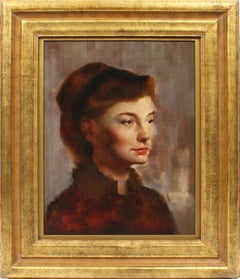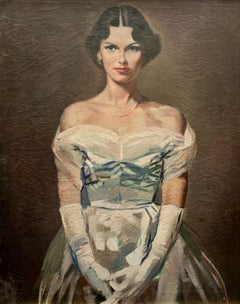Antonio Sotomayor On Sale
Portrait of a Woman in White Dress
By Antonio Sotomayor
Located in Soquel, CA
Portrait of a young woman in an elegant white dress by Antonio Sotomayor (Bolivian, 1902-1985). Signed "Sotomayor" in the lower left corner. Presented in a wood frame. Image size: 30...
Category
Late 20th Century Impressionist Portrait Paintings
Materials
Canvas, Oil
People Also Browsed
Antique American Ashcan School Original Portrait Of A Young Woman Oil Painting
Located in Buffalo, NY
Antique American school portrait oil painting. Oil on board, circa 1930. Unsigned. Displayed in a giltwood frame. Image, 13"L x 17"H.
Category
1930s Impressionist Portrait Paintings
Materials
Oil, Canvas
H 24 in W 20 in D 2 in
Portrait of a Woman
By Charles Ellis
Located in Fort Washington, PA
Medium: Oil Painting
Signature: Unsigned
Contact for dimensions.
Category
20th Century Portrait Paintings
Materials
Oil
Two Happy Sisters - Portrait of two black girls - Royal
Located in Antwerp, BE
A portrait of two young girls by the Royal Portraitist Chen Yanning.
Both the artist as well as the sitters of this magnificent portrait are from racial minorities. It's a sweet im...
Category
19th Century American Realist Portrait Paintings
Materials
Oil, Canvas
"POP" Ingrid Baars X Popovy Sisters 35x40 in Original photography Edition of 12
By Popovy Sisters
Located in Culver City, CA
"POP"
Ingrid Baars X Popovy Sisters
35" x 40" inch
Original photography Edition of 12
Dutch Visual Artist Collaborated With Doll Makers To Create Surreal Art.
Archival pigment...
Category
21st Century and Contemporary Modern Portrait Photography
Materials
Archival Pigment, Rag Paper
Popovy Sisters"POP" Ingrid Baars X Popovy Sisters 35x40 in Original photography Edition of 12 , 2018
Free Shipping
H 35 in W 40 in D 1 in
19th Century Oil Painting of a French Victorian Lady with a Black Hat Framed
Located in New York, NY
19th century gilt framed oil painting portrait of lady wearing black hat and blue striped dress.
Category
Antique Late 19th Century Victorian Paintings
Materials
Canvas
H 58.25 in W 48.25 in D 2 in
Blue Sister, Oil Painting
By Adrienne Stein
Located in Denver, CO
Adrienne Stein's "Blue Sister" is an oil painting created in 2019 depicting female model with red hair.
About the artist:
Adrienne Stein (b. 1986) is an award winning artist living...
Category
2010s Realist Portrait Paintings
Materials
Oil
Unknown: Portrait of a Scottish Lady Oil on Canvas
Located in Montreal, QC
This historical portrait of a Lady, was chosen for exhibition at the "Palace of History" in the Scottish Exhibition in Glasgow in 1911.
She is fashionably dressed in evening clothes...
Category
Antique Mid-19th Century Scottish Victorian Paintings
Materials
Paint
French Victorian Lady and Poodle Portrait
Located in New York, NY
French Victorian (19/20th Cent) oil painting portrait of a lady and French poodle with blue bow in walnut and ebonized frame.
Category
Antique 19th Century French Victorian Paintings
Materials
Walnut
19th Century Oil Portrait of Two Sisters With Their Dog c.1870
Located in San Francisco, CA
19th Century Oil Portrait of Two Sisters With Their Dog c.1870
Outstanding antique oil portrait on wooden panel of two fashionably dressed sisters picking flowers as they walk their...
Category
Mid-19th Century Portrait Paintings
Materials
Oil, Wood Panel
Sisters
By Jackie Gordon
Located in New York, NY
Innocence of childhood. Portrait.
About the Artist:
My art is a visual recording of the powerful imagines that occur regularly in life, distilling them down and preserving the ...
Category
2010s Contemporary Portrait Paintings
Materials
Canvas, Oil
Late 19th Century American Victorian Oil Painting Portrait of a Lady
Located in New York, NY
American Victorian oval oil painting portrait of lady in black with cameo in gilt filigree carved frame.
Category
Antique Late 19th Century American Victorian Paintings
Materials
Canvas
French Victorian Yorkshire Terrier Lady Portrait
By Thierry Poncelet 1
Located in New York, NY
French Victorian style gilt framed oil painting portrait of a yorkshire terrier dressed as a lady in black with a white lace collar (signed: PONCELET).
Category
Antique Late 19th Century Victorian Paintings
Materials
Canvas
19th Century Miniature Framed English Victorian Lady Portrait
Located in New York, NY
English Victorian miniature oil painting portrait on bone of a seated lady wearing a black dress in leather case (signed: Charles J BASEBE 1841).
Category
Antique 19th Century British Victorian Paintings
Materials
Leather
Pair of 19th Century American Victorian Framed Oil Painting Portraits
Located in New York, NY
Pair of ebonized framed oil painting portraits of lady with hair up and man with long beard.
Category
Antique Late 19th Century American Victorian Paintings
Materials
Canvas
19th Century English Victorian Lady in Lace Portrait
Located in New York, NY
English Victorian 19th century oil portrait painting of lady wearing white lace and red gloves in bleached carved frame.
Category
Antique 19th Century British Victorian Paintings
Materials
Canvas
American Framed Oil Painting of an Victorian Lady in White Signed Wentworth
Located in New York, NY
American Victorian oil on canvas painting portrait depicting a seated lady in white dress & hat with umbrella within a gilt frame (sgnd C.D. Wentworth).
Category
Antique Late 19th Century American Victorian Paintings
Materials
Canvas, Paint
Get Updated with New Arrivals
Save "Antonio Sotomayor On Sale", and we’ll notify you when there are new listings in this category.
More Ways To Browse
Terra Cotta Peru
Peruvian Terra Cotta
Louis Vuitton Fusion
Picasso Toro Y Toreros 1959
Van Goyen
Used Geodesic Dome
Michael Budden Ocean Beach
Record Promo Poster
Vintage Yorkshire Posters
Williamsburg Bridge
Vintage Leather Album
Barton Bened
Woodruff Oil
White Bookplate
Art Nou
Chebotaru Andrey
Bordeaux Map
Anastasia Kurakina On Sale


